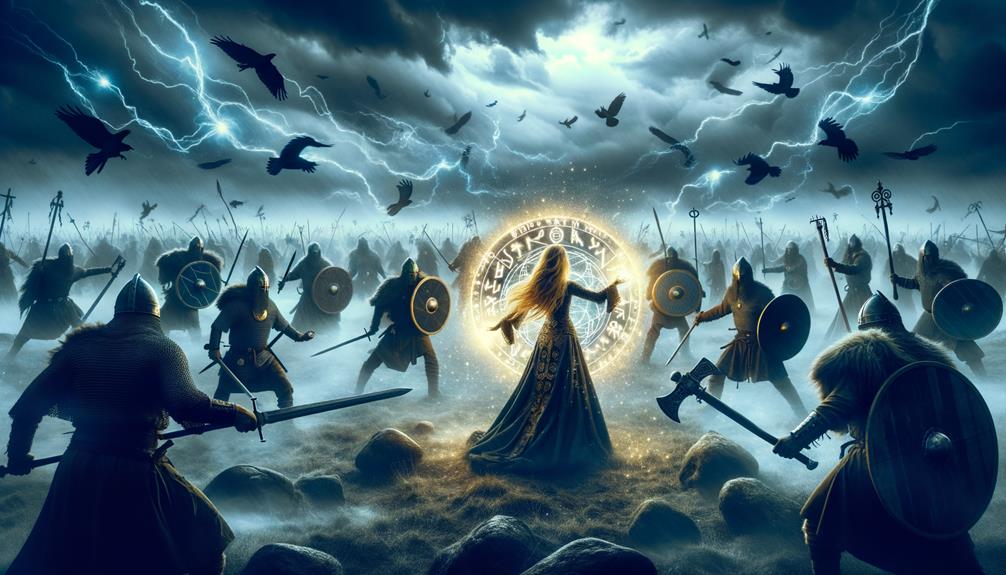In Norse mythology, a pivotal figure named Gullveig played a key role in the outbreak of the Aesir-Vanir war. Known for her ties to gold and enchanting magic known as seiðr, Gullveig became the target of the Aesir gods. The Aesir’s harsh assault on Gullveig ignited a feud with the Vanir gods, who were closely associated with nature and fertility.
Later on, Gullveig reemerged as Heiðr, which only served to fuel the ongoing dispute. Her transformation mirrored the cycle of life and death, a common theme in Norse stories. This clash escalated into the first cosmic war, a dispute over unresolved debts which served as a stark warning about the consequences of actions in Norse mythology.
The events surrounding Gullveig and the war are complex, with multiple layers of symbolism and meaning waiting to be uncovered. This makes the Gullveig Hunt War an intriguing part of Norse mythology that’s well worth looking into.
The Mysterious Figure: Gullveig
When you dive into Norse mythology, Gullveig is a character that stands out due to her mystique. She’s known for her connection to magic, gold and the concept of rebirth, which makes her a key figure in these ancient stories. As a Vanir goddess, it’s believed she practiced seiðr, a form of ancient Norse magic. This suggests she was a powerful and influential figure in her time.
Gullveig’s transformation into Heiðr, another character known for practicing seiðr, highlights her importance even more. This change isn’t just physical; it symbolizes her ability to cheat death and embodies the cycle of life and death. While experts continue to debate her true identity, there’s no denying her character fascinates us, reflecting themes of power, consequences, and the cyclical nature of life.
Triggers of the Aesir-Vanir War
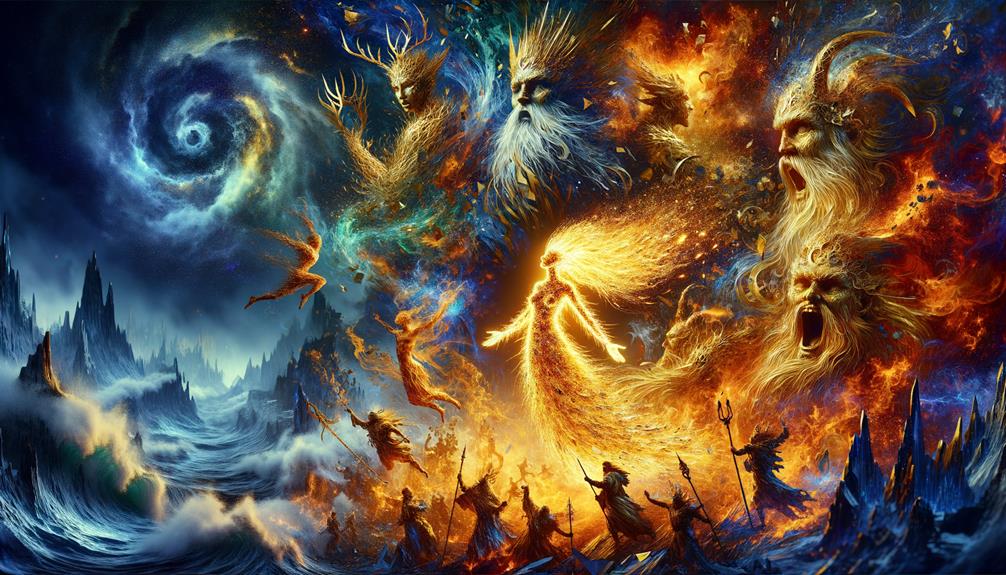
When we’re talking about what sparked the Aesir-Vanir War, we can’t ignore the events that kicked everything off and the simmering tensions that were already there. The Aesir tried to execute Gullveig and then blamed her potent seidr magic for all their problems – this was where the real trouble started. The hostility that followed was just the icing on the cake. If you look at the main occurrences during the war, what happened afterwards, and the effects it had, you’ll get a better idea of this mythological showdown and why it still matters today.
Initial Conflict Causes
The Aesir-Vanir war had a fiery beginning, ignited by the Aesir’s harsh assault on Gullveig. She was a mighty goddess from the Vanir tribe, feared and respected for her magical abilities. The Aesir believed she was the root of their moral downfall, prompting them to attempt her murder. This action sparked a fierce rivalry between the two clans. Gullveig, however, was not easily defeated. Despite being burned and stabbed with spears, she survived and morphed into Heiðr, adding fuel to the escalating feud. The initial clash was a fierce blend of mystical strategies and raw power, signaling the onset of the Aesir-Vanir war.
| Event | Cause | Effect |
|---|---|---|
| Aesir’s Assault on Gullveig | Alleged Moral Corruption | Outbreak of Rivalry |
| Gullveig’s Survival and Transformation | Aesir’s Murder Attempt | Intensification of Feud |
| First Battle | Blend of Magic and Power | Commencement of Aesir-Vanir War |
Key War Events
Let’s dive into the chain of events that set off the Aesir-Vanir war. It all began with Gullveig’s fiery ordeal and her extraordinary ability to bounce back to life. Here’s a rundown of the three major triggers:
- Gullveig’s burning: The Aesir held Gullveig responsible for their decline in morality and set her aflame three times in a bid to end her influence. However, this act only sparked the flames of war instead.
- Gullveig’s resurrection: Remarkably, Gullveig managed to survive each time she was burned, coming back to life again and again. The Aesir grew more frightened by her resilience, which only added fuel to their hostility towards the Vanir.
- Gullveig’s transformation: When Gullveig transformed into Heiðr, a highly respected seer, it further strained the already tense relations between the two tribes.
Gullveig’s ordeal and transformation served as the major turning points in the narrative of the Aesir-Vanir War, profoundly shaping the course and outcome of the conflict.
Aftermath and Impacts
In the wake of Gullveig’s fiery experience and remarkable rise from the ashes, a wave of unease and dread washed over the Aesir and Vanir tribes. This incident triggered the start of a brutal struggle that would permanently reshape their collective folklore. When Gullveig defied death and was reborn as Heiðr, it fueled the Aesir’s resentment and hostility. In the context of Norse Mythology, they viewed this as a disruption to their ethical principles, which sparked a war among the Aesir. Gullveig’s transformation represented the enduring power of wisdom and mysticism, which only heightened the tension. The ripple effects of this event were significant. Gullveig’s survival and teachings became key factors in the war, influencing its roots and consequences. As a result, the aftermath of Gullveig’s ordeal and rebirth marked a turning point in the history of these tribes.
Gullveig’s Undying Presence
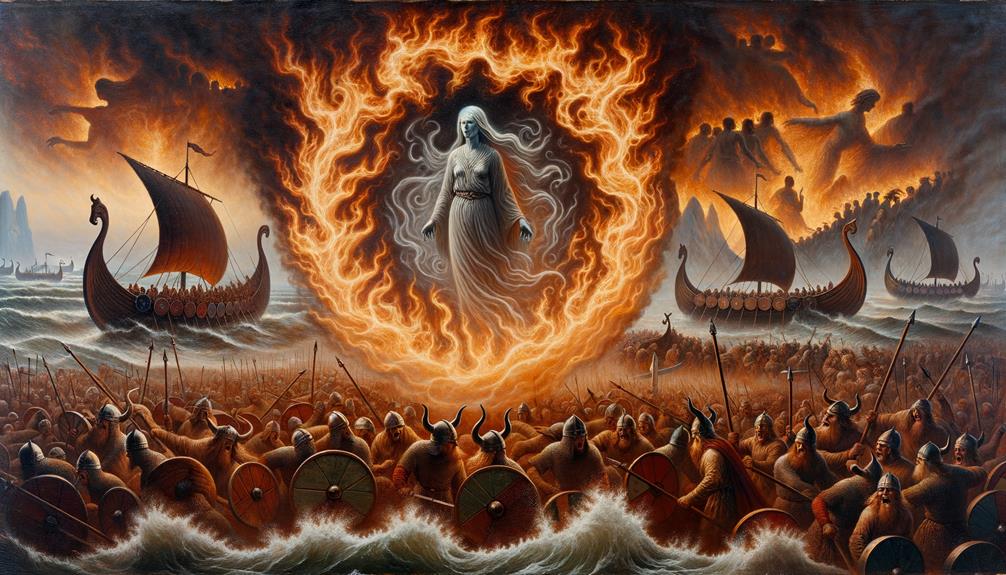
In the world of Norse mythology, Gullveig is a figure who truly stands out. She’s the epitome of resilience, with a story that demonstrates her incredible ability to survive and transform. It’s a tale that still resonates today, making her a key character in the annals of Norse legends.
Let’s talk about why:
- Gullveig’s tale includes surviving three burnings, a feat that showcases her remarkable resilience and strength. It’s a striking part of her story that carries a lot of symbolism.
- When Gullveig transformed into Heiðr, the witch, it wasn’t just a physical change. She continued to impart her knowledge of seiðr, ensuring her influence lived on.
- It’s important to note that ill women loved Heiðr’s teachings, which is a testament to Gullveig’s enduring impact. Even after death, she thrived in her new form and continued to influence others.
These factors clearly illustrate that Gullveig’s influence in Norse mythology is deeply rooted and enduring. Her story is a testament to her importance and enduring influence in this cultural context.
The Role of the Vanir
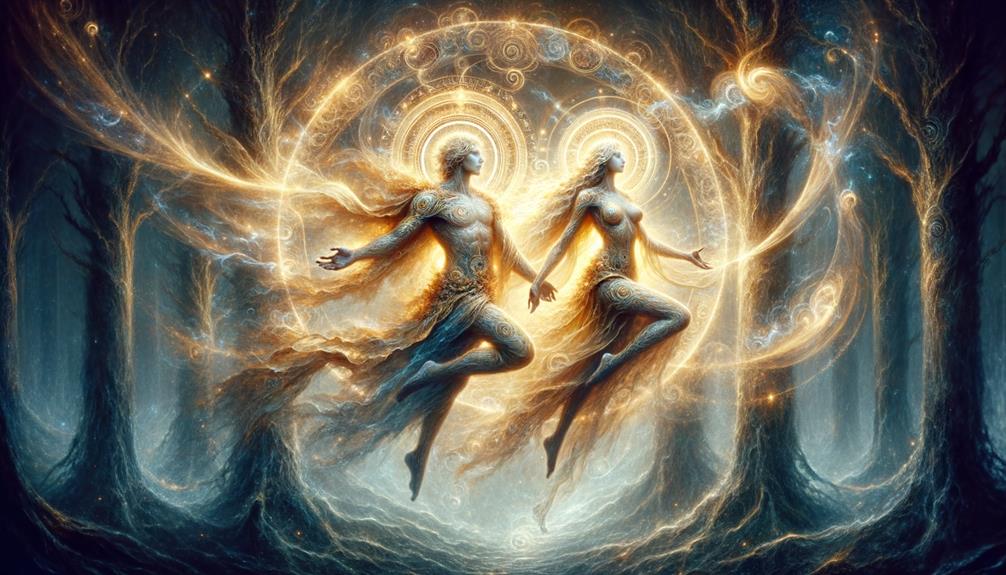
Taking a closer look at Norse mythology, one can’t miss the influence of the Vanir, a group of gods known for their links to fertility, nature, and magic. They had a crucial part to play in the story’s development. Their participation in the Aesir-Vanir war, sparked by a disagreement between Gullveig and the Aesir, shows their durability and magical skills. Freyja, a well-known Vanir goddess, is famous for her mastery of seidr, a form of magic related to foretelling and fate alteration, making the Vanir’s unique powers stand out even more. Njord and Freyr’s efforts in making peace between the Aesir and Vanir emphasize the Vanir’s dedication to diplomacy and unity. These aspects of the Vanir’s personality enrich the mythology, showing us the different ways power and conflict resolution can be approached.
Consequences and Payments in Norse Mythology
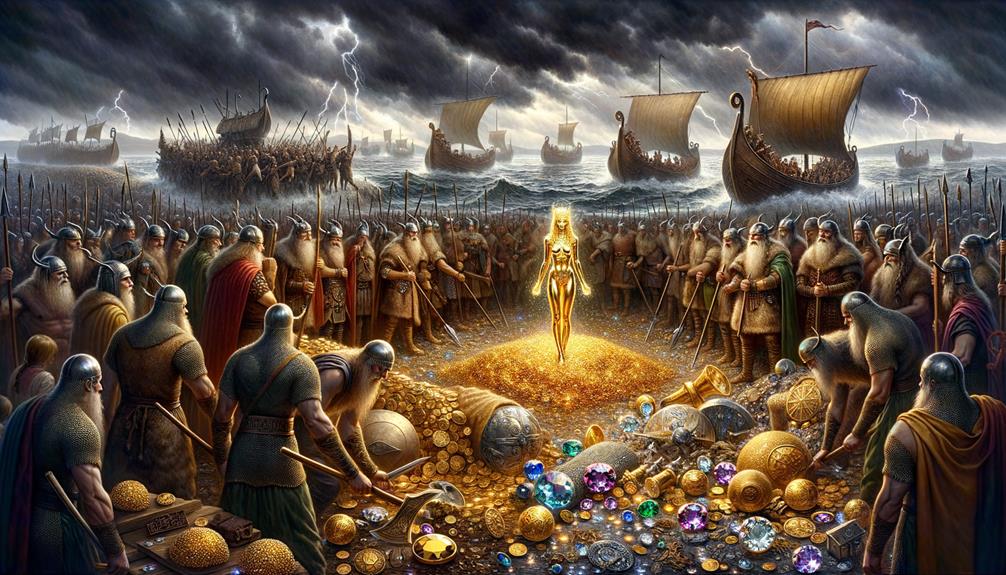
Norse mythology, chock-full of stories about gods and creatures, is riddled with intriguing themes. Among these themes, the concept of payback and the fallout from our actions is a standout. You’ll see this woven into many tales, like the prophecy of Ragnarok or the tale of Gullveig/Angrboda, for instance.
Take the story of Angrboda, who keeps coming back to life, as a prime example. This underlines the persistent, unavoidable nature of the fallout when we violate natural laws and duties. It’s like a boomerang, what goes around, comes around!
This idea plays a critical role in understanding the conflict between the Aesir and Vanir, two groups of Norse gods. But it’s not just about the clashes among gods; it also offers us a deep peek into the moral code embedded in these ancient Norse stories. So, to unravel the complexities of Norse mythology, consider the theme of consequences and payments as a key to unlock the treasure chest of these intricate tales.
Norse Mythologys Consequences
Norse mythology, particularly the Aesir-Vanir war, is a fascinating blend of resilience, power, and the high price of ignoring natural laws. Let’s talk about three main points:
- Let’s start with Gullveig. This character, whose name is synonymous with gold, is a perfect example of resilience. It’s her refusal to succumb to death that sparks the war.
- Then we have the Vanir. Their role in the war really showcases the strength of sticking to your guns. Their determination to fight adds depth to the whole conflict.
- Finally, the Aesir. They’re all about knowledge, even when it comes from the Jotnar. This pursuit, though, shows us what can go wrong when you disregard natural laws.
Payments in Norse Lore
The intriguing world of Norse mythology is filled with tales of duty, accountability, and the consequences of our actions. It’s a lot like a complex system of ‘payments’, if you will. Just take a look at the Aesir and Vanir, two dominant groups of gods in these stories.
When obligations fall through, it’s not a pretty sight – it often brews conflict, even warfare. A prime example is the Aesir-Vanir War, the first ever cosmic war. It all started because the Aesir didn’t settle their debts.
It’s a compelling lesson about understanding the effects of our actions. In other words, Norse mythology is a masterclass on the delicate balance of cause and effect, and the critical role of ‘payments’.
Gullveig’s Impact on Modern Interpretations
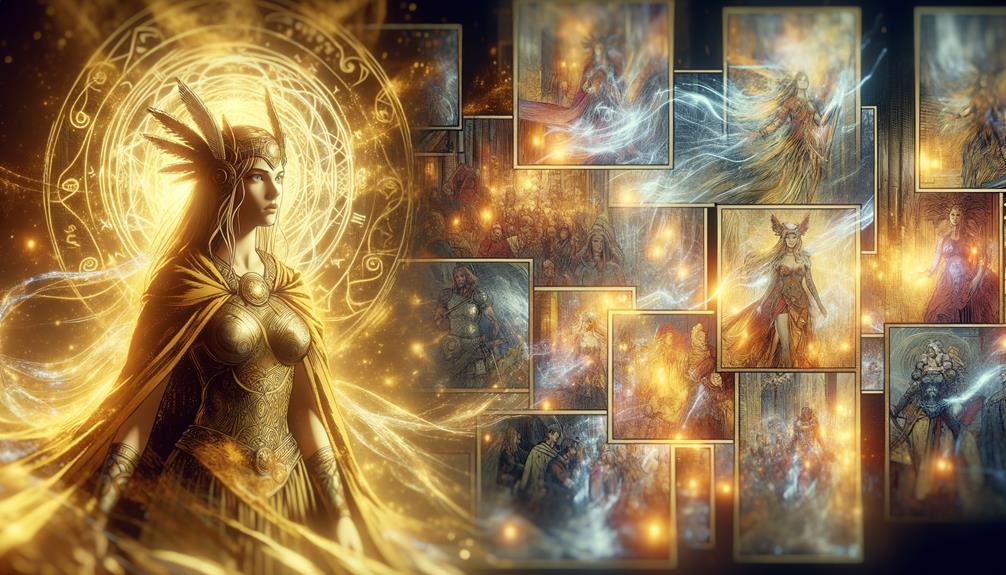
When you dive into the world of modern Norse mythology, you’ll find that Gullveig is a key player. This mystical woman is often connected with powerful clairvoyants and crucial mythological events, making her one of the most puzzling ladies in the lore. Many believe she’s the one who started the first war among the gods.
- A lot of researchers think Gullveig, Angrboda, and Heidr are actually the same person, just with different names.
- Some people think she’s tied to the Vanir-Jotnar alliance, which had a big effect on the Ragnarok prophecy.
- Gullveig’s links to themes of payback, judgement, and breaking natural laws keep modern fans fascinated.
Her role in Norse mythology is clearly massive, shaping how we understand its classic stories.
Frequently Asked Questions
Why Was Gullveig Killed?
So, why was Gullveig killed, you might ask? Well, it’s quite an interesting story. Gullveig, with her powerful influence, sparked a sense of unease and fear within the Aesir. They saw her abilities as a threat, and this fear led to her demise. Her death, however, didn’t go unnoticed by the Vanir, and it set off a chain of serious consequences, ultimately escalating into a full-blown war.
What Was the Biggest War in Norse Mythology?
If you’re curious about the largest conflict in Norse mythology, look no further than the Aesir-Vanir War. This epic clash had a profound influence on Norse culture, providing important teachings about disputes, empathy, and the value of peaceful living. It was a war that not only shaped the mythological landscape but also offered practical lessons on strategic warfare and conflict resolution. Just remember to keep in mind that this isn’t just a tale of gods and giants; it’s a story about the struggles and triumphs we encounter in our own lives.
What Is Gullveig the Goddess Of?
In Norse mythology, Gullveig is best known as the goddess who holds sway over magic and prophecy. She’s a real game-changer, especially when it comes to manipulating fate and influencing the lives of humans. Through her resilience and ability to thrive in the face of conflict and hardship, she embodies the sheer power of transformation and survival.
Why Do Aesir and Vanir Hate Each Other?
From the viewpoint of the Vanir, they held a grudge against the Aesir due to their dominance and authority. The Aesir, conversely, found it hard to comprehend the Vanir’s reliance on magic. This mutual misunderstanding and fear sowed the seeds of animosity between these two tribes.

